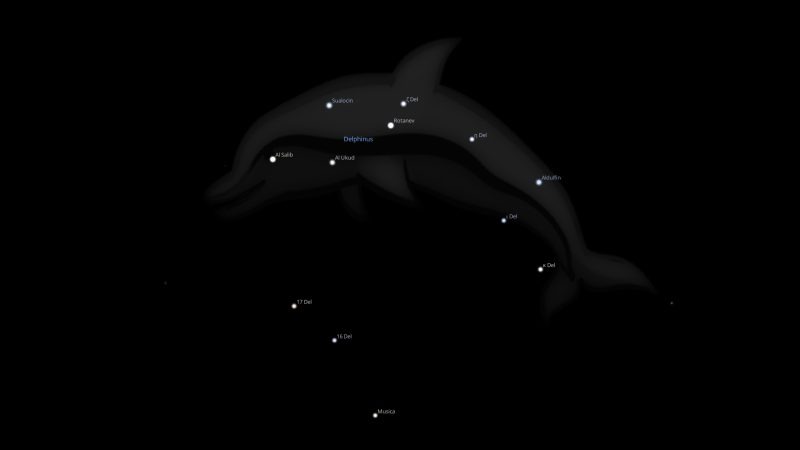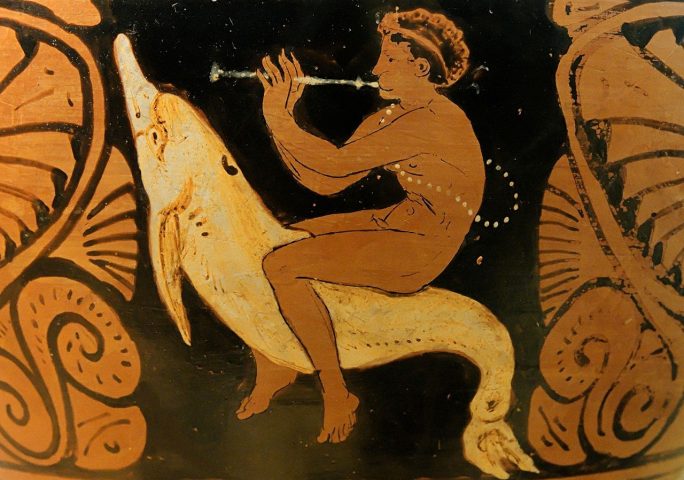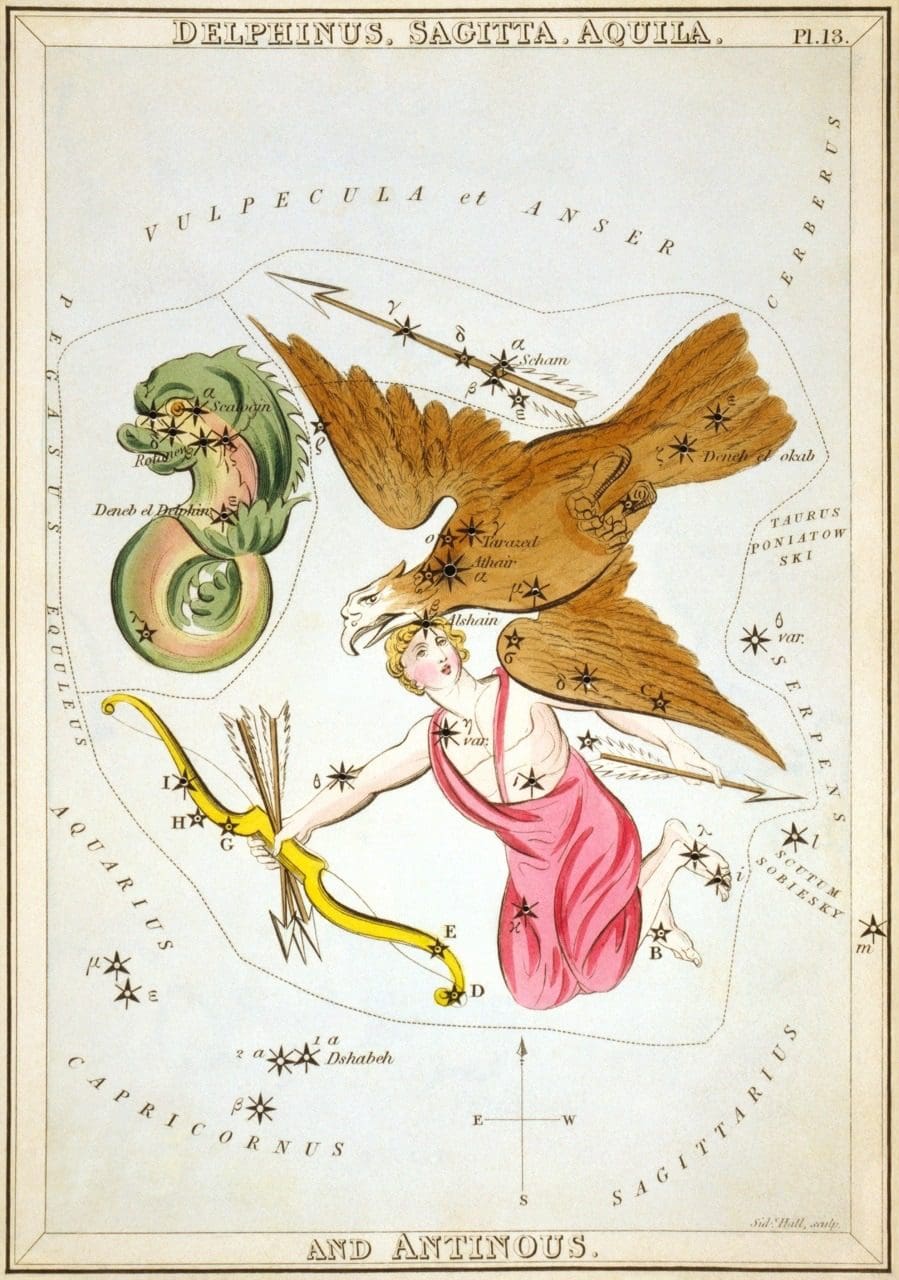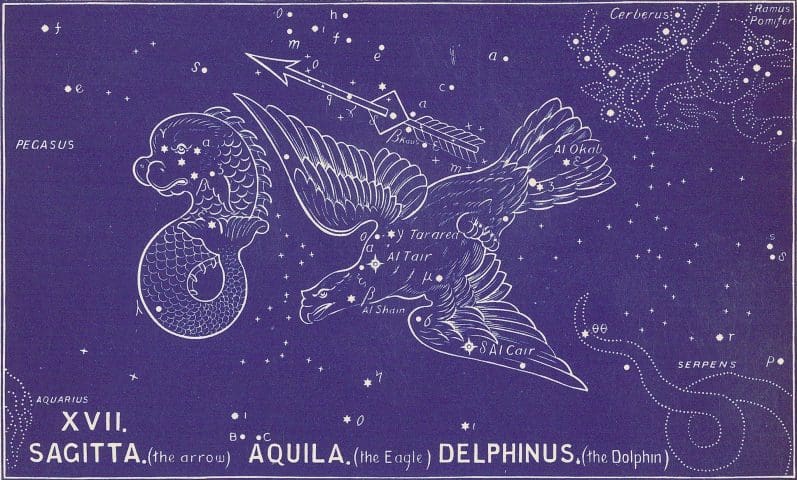FIXED STARS: Major Stars | 1000+ Stars | Constellations | About
Constellation Delphinus the Dolphin is a northern constellation bordering Aquarius, Equuleus, Pegasus, Vulpecula, Sagitta, and Aquila.It is one of the 48 constellations listed by Ptolemy in the 2nd century and remains one of the 88 modern constellations. Delphinus spans over 7 degrees of the zodiac in the Sign of Aquarius.
Abbreviation: Del
Genitive: Delphini
Delphinus Constellation Stars
| 2000 | 2050 | Star | Name | Sp. Class | Mag. | Orb |
|---|---|---|---|---|---|---|
| 14♒03 | 14♒45 | ε Del | Aldulfin | B6 | 4.03 | 1°20′ |
| 16♒20 | 17♒02 | β Del | Rotanev | F5 | 3.62 | 1°40′ |
| 17♒23 | 18♒05 | α Del | Sualocin | B9 | 3.77 | 1°30′ |
| 18♒07 | 18♒49 | δ Del | Al Ukud | A7 | 4.43 | 1°10′ |
| 19♒22 | 20♒04 | γ Del | Al Salib | K1 | 3.87 | 1°30′ |
| 20♒35 | 21♒17 | 18 Del | Musica | G6 | 5.51 | 1°00′ |
β Del is officially and historically named Rotanev.
The Sicilian astronomer Niccolò Cacciatore named α Del and β Del after himself:
The English translation of Niccolò Cacciatore is Nicholas Hunter.
The Latin translation of Nicholas Huter is Nicolaus Venator.
Reversing Nicolaus Venator gives Rotanev Sualocin.
Al Bīrūnī (973) said that the early Christians, the Melkite and Nestorian sects, considered Delphinus the Cross of Jesus transferred to the skies after his crucifixion. Al-Qazwini (1203) said α, β, γ, and δ Del were Al ʽUḳūd, “the Pearls” or “Precious Stones” adorning Al Ṣalīb, “the Cross,” with ε Del, towards the tail, being Al ʽAmūd al Ṣalīb, “the Pillar of the Cross.” [1]
γ Del is named Al Salib, from the Arabic al Ṣalīb, “the Cross.”
δ Del is named Al Ukud, from the Arabic al ʽUḳūd, “the Pearls.”
ε Del is officially and traditionally named Aldulfin, from the Arabic dhanab ud‑dulfīn, “the tail of the dolphin.” [2] This star sometimes appears as Al Amud al Salib, “the Pillar of the Cross.”
18 Del is named Musica, Latin for “music” [2] In continuation of the Greek story of Arion and his Lyre appears Μουσικόν ζώδιον, the Musicum signum of the Latins. [1]
Asterisms
α, β, γ, δ Del were Al Ukud, from the Arabic al‑ʿuqūd, “the Pearls.” [1]
α, β, γ, δ Del are the 23rd Vedic Nakshatra Dhanishta (श्रविष्ठा). [3]
α, β, γ, δ, ζ, 10, 15, 16, 17 Del belong to the Chinese asterism Hùguā (瓠瓜), “Good Gourd” [4]
ε, η, θ, ι, κ, 1, 13, 14 Del belong to the Chinese asterism Bàiguā (敗瓜), “Rotten Gourd” [4]
Delphinus Astrology
Manilius (@35 AD)
But when the Dolphin’s Fires begin to rise
With Stars like Scales, and swim in Liquid Skies;
It shall be doubtful which shall most Command
The Inclination for the Sea or Land:
Both shall conspire, and in one Mass combind,
Now this way draw, now that way force the Mind:
For as the Dolphin mounts, now dives again,
Now turns, now leaps, and figures all the Main:
So those that shall be born shall now divide
With wide stretcht Arms, and beat the swelling Tide;
Now thrust them downward, and with secret Oars
Their Bodies row, and visit Foreign Shores;
Now tread the Water, with their Feet maintain
Themselves Erect, and wade the deepest Main,
As t’were a shallow; like the firmest Field,
The Floods shall bear them, and refuse to yield:
Now on their Backs or Sides securely keep
One constant place, and lie upon the Deep:
No Oar to Boy them up; but Floods forget
Their natural yielding, and sustain the Weight:
Or they shall dive, through boundless Oceans go,
And visit Nereus, and the Nymphs below;
Or take up Shipwracks, Merchants Spoils restore,
And rob the greedy Ocean of its Oar.
To these joyn those, who from an Engine tost
Pierce through the Air, and in the Clouds are lost;
Or poize on Timber, where by turns they rise
And sink, and mount each other to the Skies:
Or leap through Fire, and fall on hardest Ground
As on soft Seas, unhurt, and safe from Wound:
Tho’ void of Wings, their Bodies boldly rear,
And imitate their Dolphin in the Air.
Or if they want the skill, yet Nature’s part
Perform’d, they shall be nimble without Art:
Not run, but rather fly, be swiftly born
O’re Fields of Wheat, nor bend the standing Corn. [5]
When the sea-dark Dolphin ascends from the Ocean to the heavens and emerges with its scales figured by stars, birth is given to children who will be equally at home on land and in the sea. For just as the dolphin is propelled by its swift fins through the waters, now cleaving the surface, now the depths below, and derives momentum from its undulating course, wherein it reproduces the curl of waves, so whoever is born of it will speed through the sea. Now lifting one arm after the other to make slow sweeps he will catch the eye as he drives a furrow of foam through the sea and will sound afar as he thrashes the waters; now like a hidden two-oared vessel he will draw apart his arms beneath the water; now he will enter the waves upright and swim by walking and, pretending to touch the shallows with his feet, will seem to make a field of the surface of the sea; else, keeping his limbs motionless and lying on his back or side, he will be no burden to the waters but will recline upon them and float, the whole of him forming a sail-boat not needing oarage.
Other men take pleasure in looking for the sea in the sea itself: they dive beneath the waves and try to visit Nereus and the sea nymphs in their caves; they bring forth the spoils of the sea and the booty that wrecks have lost to it, and eagerly search the sandy bottom.
From their different sides swimmers and divers share an equal enthusiasm for both pursuits, for their enthusiasm, though displayed in different ways, springs from a single source.
With them you may also reckon men of cognate skill who leap in the air, thrown up from the powerful spring-board, and execute a see-saw movement, the first’s descent throwing up the second and the plunge of the second lifting the first on high; or hurl their limbs through the fire of flaming hoops, imitating the dolphin’s movement in their flight through space, and land as gently on the ground as they would in the watery waves: they fly though they have no wings and sport amid the air.
Even if the Dolphin’s sons lack these skills, they will yet possess a physique suited to them; nature will endow them with strength of body, briskness of movement, and limbs which fly over the plain. [6]
Ptolemy (@150 AD)
those in Delphinus, of Saturn and Mars; [7]
Maternus (@335 AD)
In the 8th degree of Capricorn, Delphinius (β Del) arises. Whoever is born in the east of this star will have a passion for swimming, but with the testimony of Saturn he will be a diver, but with Mars and Mercury he will be a rope dancer, acrobat, gymnast, or certainly a sailor, with a course of agility. But if his star is found in the setting, and Saturn looks at this place with a threatening radiation, he will be drowned in the sea or in a river by storms and whirlwinds. [8]
Lily (1647)
The constellation of the Dolphin portends one of simple looks, but cheerful in hawking, hunting, and other pleasing sports, yet of double intentions, or in plain terms, one that speaks one thing, and intends another, or dissembles with his best friends. [12]
Allen (1889)
Delphinus, the Dolphin,
It now is one of the smallest constellations, but originally may have included the stars that Hipparchos set off to form the new Equuleus; and in all astronomical literature has borne its present title and shape, with many and varied stories attached, for its namesake was always regarded the most remarkable of marine creatures.
In Greece it also was Ieros Ikhthus, the Sacred Fish, the creature being of as much religious significance there as a fish afterwards became among the early Christians; and it was the sky emblem of philanthropy, not only from the classical stories connected with its prototype, but also from the latter’s devotion to its young. It should be remembered that our stellar Dolphin is figured as the common cetacean, Delphinus delphis, of Atlantic and Mediterranean waters, not the tropical Coryphaena that Dorado represents.
Ovid, designating it as clarum sidus, personified it as Amphitrite, the goddess of the sea, because the dolphin induced her to become the wife of Neptune.
The Hindus, from whom the Greeks are said to have borrowed it, although the reverse of this may have been the case, knew it as Shī-shu-māra, or Sim-shu-māra, changed in later days to Zizumara, a Porpoise, also ascribed to Draco. And they located here the 22d nakshatra, Çravishthā, Most Favorable, also called Dhanishthā, Richest; the Vasus, Bright or Good Ones, being the regents of this asterism, which was figured as a Drum or Tabor; β marking the junction with Catabishaj.
Brown thinks that it may have been the Euphratean Makhar, although Capricorn also claimed this.
Al Bīrūnī, giving the Arabic title AI Ḳaʽūd, the Riding Camel, said that the early Christians — the Melkite and Nestorian sects — considered it the Cross of Jesus transferred to the skies after his crucifixion; but in Kazwini’s day the learned of Arabia called α, β, γ and δ Al ʽUḳūd, the Pearls or Precious Stones adorning Al Ṣalīb, by which title the common people knew this Cross; the star ε, towards the tail, being Al ʽAmūd al Ṣalīb, the Pillar of the Cross. But the Arabian astronomers adopted the Greek figure as their Dulfīm, which one of their chroniclers described as “a marine animal friendly to man, attendant upon ships to save the drowning sailors.”
The Chinese called the four chief stars and ζ Kwa Chaou, a Gourd. [1]
Bullinger (1893)
DELPHINUS (The Dolphin).
The Dead One Rising again.
This is a bright cluster of 18 stars, five of which are of the 3rd magnitude. It is easily distinguished by the four brightest, which are in the head.It is always figured as a fish full of life, and always with the head upwards, just as the eagle is always with the head downwards. The great peculiar characteristic of the dolphin is its rising up, leaping, and springing out of the sea.
In the Persian planisphere there seems to be a fish and a stream of water. The Egyptian has a vessel pouring out water.
The ancient names connected with this constellation are Dalaph (Hebrew), pouring out of water; Dalaph (Arabic), coming quickly; Scalooin (Arabic), swift (as the flow of water); Rotaneb or Rotaneu (Syriac and Chaldee), swiftly running. [9]
Robson (1923)
DELPHINUS. The Dolphin.
Legend. When Amphitrite, who was sought as a wife by Neptune, hid herself, the God sent messengers to find her. The dolphin was the first to succeed and persuaded her to consent to the marriage, for which service Neptune placed him in the heavens. According to other accounts it is one of the pirates who were changed into dolphins by Bacchus on his voyage to Ariadne.
Influence. According to Ptolemy, Delphinus is like Saturn and Mars. It gives a simple appearance, cheerfulness, dissembling and duplicity, love of hunting, and sport in general but little happiness. There is a fondness for pleasure, ecclesiastical matters and travel, but danger of suffering from ingratitude. [10]
Noonan (1990)
The Constellation of the Dolphin
In addition to the signs of the zodiac, many of the constellations are also very important when it comes to delineating the potential character of the native at birth. Delphinus (Del) or the constellation of the Dolphin is one of these. In greece it was called the Sacred Fish. It is the sky emblem of philanthropy and its bright stars are of the nature of Mercury and Jupiter, although there are others as Saturn and Mars. It denotes an individual devoted to his children and of a very religious nature. The Martian element manifests itself in love of hunting and sport, while that of Saturn portends a difficulty in finding true happiness. In judicial astrology the constellation presages good fortune in regards the sea. [11]
Lunar Manion
23rd Vedic Nakshatra Dhanishta (श्रविष्ठा).
Ruled by Mars. Star of Symphony. Power to give abundance and fame.
Meaning: The Most Famous, The Swiftest, The Most Heard Of, The Wealthiest, The Most Benevolent, Shravishta.
Rulership: men without pride, eunuchs, fast friends, men who are hated by women, charitable persons, the very wealthy, peaceful (self-controlled) persons. 3
References
- Star Names: Their Lore and Meaning, Richard H. Allen, 1889, pp. 198-201.
- SkyEye: (Un)Common Star Names.
- 23. Dhanishta Nakshatra – MikesSleepingDog.
- Delphinus in Chinese Astronomy – Wikipedia.
- Astronomica, Manilius, 1st century AD, Book 5, p.335-337. (Goold, 1977).
- Astronomica, Manilius, 1st century AD, Book 5, p.71. (Creech, 1700).
- Tetrabiblos, Ptolemy, 2nd century AD, Book 1, p.57.
- Maternus, Julius Firmicus, Mathesis, 336 AD, viii 15.2.
- The Witness of the Stars, E. W. Bullinger, 1893, Delphinus (The Dolphin).
- Fixed Stars and Constellations in Astrology, Vivian E. Robson, 1923, p.42-43.
- Fixed Stars and Judicial Astrology, George Noonan, 1990, p.28.
- Christian Astrology, William Lilly, 1647, pp. 538.



